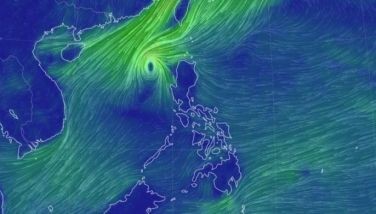ARMM moves to protect seaweed growers
January 26, 2006 | 12:00am
COTABATO CITY — While the Autonomous Region in Muslim Mindanao (ARMM) accounts for more than 50 percent of the country’s yearly production of exportable agar-agar, local seaweed growers remain marginalized and vulnerable to the schemes of wealthy traders who dictate the prices.
The country has five varieties of agar-agar, a source of carrageenan, which is widely used as a food extender and additive, and high-temperature lubricant, and in the manufacture of cosmetics and pharmaceuticals, among other industrial and military uses.
In 2004, the ARMM produced 472,514 metric tons of seaweeds, much higher than that of Region IX, which generated only 154,786 metric tons.
About 90 percent of the ARMM’s seaweed production in 2004 was from the island-provinces of Sulu and Tawi-Tawi, whose residents mainly rely on fishing for livelihood.
ARMM Agriculture Secretary Hadji Sajid Druz Ali, one of the organizers of the three-day Mindanao seaweed business forum here which started Tuesday, said his department’s main concern now is how to organize farmers in the region into a big group with direct marketing linkages abroad.
Seaweeds procured by "middlemen" in Zamboanga City are shipped to Cebu City, where there is a big processing plant owned by a Chinese businessman.
In some island-towns of Tawi-Tawi, businessmen engaged in agar-agar production export dry seaweeds to Malaysia and Indonesia, a scheme unduly depriving the regional government of revenue from tariffs and duties.
Druz Ali said the main objective of the three-day forum is for the ARMM’s Department of Agriculture and Fisheries, other concerned agencies, non-government organizations and seaweed growers to come up with measures to improve productivity, build tie-ups with investors and foreign donors, and establish marketing linkages with buyers abroad.
Malcolm Sarmiento, director of the central office of the Bureau of Fisheries and Aquatic Resources and the Growth with Equity in Mindanao, which has various humanitarian projects in the South funded by the United States Agency for International Development, helped organize the forum.
"Our main thrust now is to reach out to seaweed farmers to teach them how to improve their productivity (and) the quality of their harvests and if possible, how to gain profits by having access to markets abroad," Druz Ali said.
He said ARMM Gov. Datu Zaldy Ampatuan has issued a directive mobilizing regional experts to reach out to seaweed farmers in all parts of the ARMM to establish what could be the first-ever regionwide organization of agar-agar producers.
Druz Ali and Sarmiento, one of the forum speakers, agreed that support from foreign donors will boost their efforts in developing the region’s seaweed industry.
Lawyer Cynthia Guiani-Sayadi, the regional solicitor-general, said the ARMM now has a fragile peace, which is essential in luring investors and foreign donors to pour in technical and monetary support to improve the region’s seaweed industry.
The country has five varieties of agar-agar, a source of carrageenan, which is widely used as a food extender and additive, and high-temperature lubricant, and in the manufacture of cosmetics and pharmaceuticals, among other industrial and military uses.
In 2004, the ARMM produced 472,514 metric tons of seaweeds, much higher than that of Region IX, which generated only 154,786 metric tons.
About 90 percent of the ARMM’s seaweed production in 2004 was from the island-provinces of Sulu and Tawi-Tawi, whose residents mainly rely on fishing for livelihood.
ARMM Agriculture Secretary Hadji Sajid Druz Ali, one of the organizers of the three-day Mindanao seaweed business forum here which started Tuesday, said his department’s main concern now is how to organize farmers in the region into a big group with direct marketing linkages abroad.
Seaweeds procured by "middlemen" in Zamboanga City are shipped to Cebu City, where there is a big processing plant owned by a Chinese businessman.
In some island-towns of Tawi-Tawi, businessmen engaged in agar-agar production export dry seaweeds to Malaysia and Indonesia, a scheme unduly depriving the regional government of revenue from tariffs and duties.
Druz Ali said the main objective of the three-day forum is for the ARMM’s Department of Agriculture and Fisheries, other concerned agencies, non-government organizations and seaweed growers to come up with measures to improve productivity, build tie-ups with investors and foreign donors, and establish marketing linkages with buyers abroad.
Malcolm Sarmiento, director of the central office of the Bureau of Fisheries and Aquatic Resources and the Growth with Equity in Mindanao, which has various humanitarian projects in the South funded by the United States Agency for International Development, helped organize the forum.
"Our main thrust now is to reach out to seaweed farmers to teach them how to improve their productivity (and) the quality of their harvests and if possible, how to gain profits by having access to markets abroad," Druz Ali said.
He said ARMM Gov. Datu Zaldy Ampatuan has issued a directive mobilizing regional experts to reach out to seaweed farmers in all parts of the ARMM to establish what could be the first-ever regionwide organization of agar-agar producers.
Druz Ali and Sarmiento, one of the forum speakers, agreed that support from foreign donors will boost their efforts in developing the region’s seaweed industry.
Lawyer Cynthia Guiani-Sayadi, the regional solicitor-general, said the ARMM now has a fragile peace, which is essential in luring investors and foreign donors to pour in technical and monetary support to improve the region’s seaweed industry.
BrandSpace Articles
<
>
- Latest
- Trending
Trending
Latest
Trending
Latest
Recommended





























